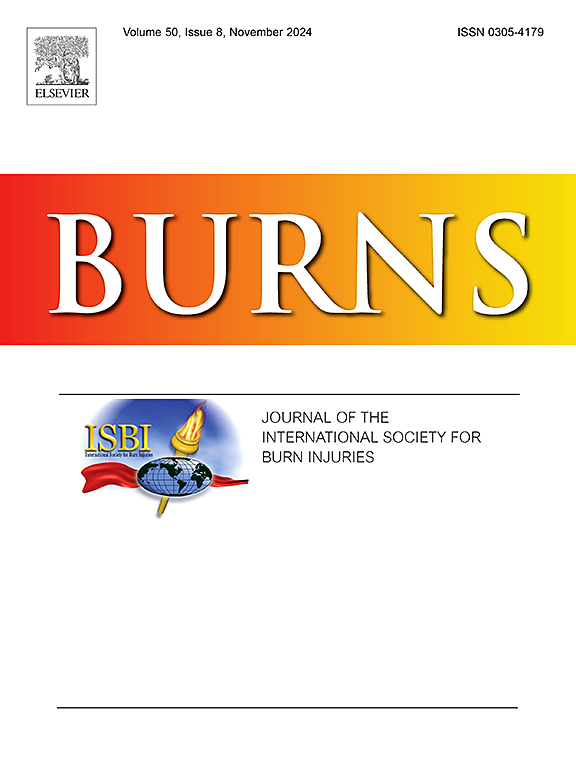Do allografts present a risk to burn patients? Allografts and HLA-sensitization
IF 3.2
3区 医学
Q2 CRITICAL CARE MEDICINE
引用次数: 0
Abstract
Objective
This meta-analysis aimed to quantify sensitization rates following allograft usage and determine whether allografts have an increased risk of long-term sensitization compared to alternative therapies in burn patients.
Methods
Systematic review, meta-analysis and meta-regression of post-operative sensitization in burn patients were performed following Preferred Reporting Items for Systematic Reviews and Meta-Analysis (PRISMA) guidance (Prospero registration: CRD42024497137). Database searches were conducted on MEDLINE, Embase, CENTRAL using ProQuest Dialog.
We included all studies reporting post-operative sensitization in burn patients that were not case series or singular case reports. Meta-analysis was used to compare the risk of sensitization for allograft versus alternative therapies.
Results
Six studies (Allograft Patients: 71; Non-Allograft Patients: 95) were included (n = 166). Overall, 73 % (CI: 39 %-92 %) of burn patients were sensitized following allograft. Patients receiving allograft were at a significantly increased risk of sensitization (OR 13.14 [95 % CI: 1.32–131.00]). However, on sub-group analysis, when directly comparing patients who received allograft and transfusion versus those who received transfusion alone, there was not a significantly increased risk of sensitization (OR 7.68 [95 % CI:.61–95.86]).
Conclusion
Allograft is associated with a significantly increased risk of sensitization in burn patients. However, it is not clear whether burn patients already receiving transfusion will have an increased risk of sensitization from adding allograft. Further studies are required to demonstrate the multifactorial causes of sensitization within the burned population to explain the significance of the contribution from allograft and/or transfusion reported within the literature. Clinicians must carefully weigh the immediate benefits of allografts against the potential long-term challenges of sensitization, especially where alternative wound therapies are possible.
同种异体移植对烧伤患者有风险吗?同种异体移植物和hla增敏
目的:本荟萃分析旨在量化同种异体移植使用后的致敏率,并确定与替代疗法相比,同种异体移植是否增加了烧伤患者长期致敏的风险。方法按照系统评价和荟萃分析首选报告项目(PRISMA)指南(Prospero注册号:CRD42024497137)对烧伤患者术后致敏进行系统评价、荟萃分析和荟萃回归。数据库检索在MEDLINE, Embase, CENTRAL使用ProQuest Dialog进行。我们纳入了所有报告烧伤患者术后致敏的研究,这些研究不是病例系列或单一病例报告。荟萃分析用于比较同种异体移植物与替代疗法致敏的风险。结果6项研究(同种异体移植患者71例;非同种异体移植患者:95例)被纳入(n = 166)。总体而言,73% % (CI: 39 %-92 %)的烧伤患者在同种异体移植后致敏。接受同种异体移植的患者致敏风险显著增加(OR 13.14[95 % CI: 1.32-131.00])。然而,在亚组分析中,当直接比较接受同种异体移植和输血的患者与单独接受输血的患者时,致敏风险没有显著增加(OR 7.68[95 % CI: 0.61 - 95.86])。结论同种异体移植与烧伤患者致敏风险显著增加相关。然而,目前尚不清楚已经接受输血的烧伤患者是否会因添加同种异体移植物而增加致敏的风险。需要进一步的研究来证明烧伤人群中致敏的多因素原因,以解释文献中报道的同种异体移植和/或输血的重要性。临床医生必须仔细权衡同种异体移植的直接益处和潜在的长期致敏挑战,特别是在可能有其他伤口治疗的情况下。
本文章由计算机程序翻译,如有差异,请以英文原文为准。
求助全文
约1分钟内获得全文
求助全文
来源期刊

Burns
医学-皮肤病学
CiteScore
4.50
自引率
18.50%
发文量
304
审稿时长
72 days
期刊介绍:
Burns aims to foster the exchange of information among all engaged in preventing and treating the effects of burns. The journal focuses on clinical, scientific and social aspects of these injuries and covers the prevention of the injury, the epidemiology of such injuries and all aspects of treatment including development of new techniques and technologies and verification of existing ones. Regular features include clinical and scientific papers, state of the art reviews and descriptions of burn-care in practice.
Topics covered by Burns include: the effects of smoke on man and animals, their tissues and cells; the responses to and treatment of patients and animals with chemical injuries to the skin; the biological and clinical effects of cold injuries; surgical techniques which are, or may be relevant to the treatment of burned patients during the acute or reconstructive phase following injury; well controlled laboratory studies of the effectiveness of anti-microbial agents on infection and new materials on scarring and healing; inflammatory responses to injury, effectiveness of related agents and other compounds used to modify the physiological and cellular responses to the injury; experimental studies of burns and the outcome of burn wound healing; regenerative medicine concerning the skin.
 求助内容:
求助内容: 应助结果提醒方式:
应助结果提醒方式:


